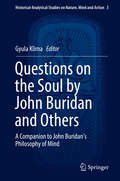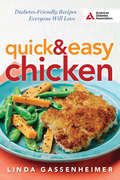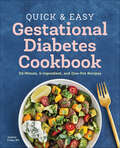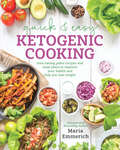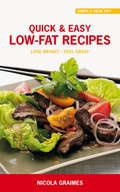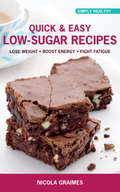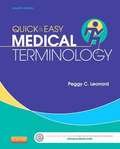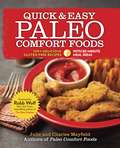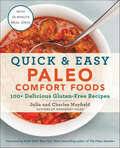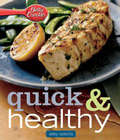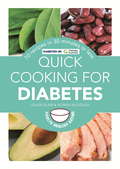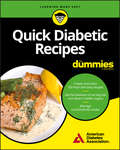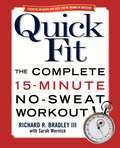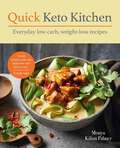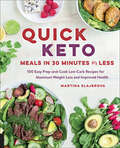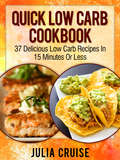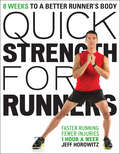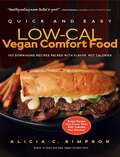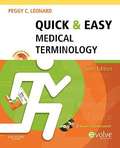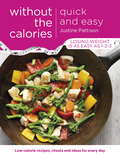- Table View
- List View
Questions on the Soul by John Buridan and Others
by Gyula KlimaThis volume features essays that explore the insights of the 14th-century Parisian nominalist philosopher, John Buridan. It serves as a companion to the Latin text edition and annotated English translation of his question-commentary on Aristotle's On the Soul. The contributors survey Buridan's work both in its own historical-theoretical context and in relation to contemporary issues. The essays come in three main sections, which correspond to the three books of Buridan's Questions. Coverage first deals with the classification of the science of the soul within the system of Aristotelian sciences, and surveys the main issues within it. The next section examines the metaphysics of the soul. It considers Buridan's peculiar version of Aristotelian hylomorphism in dealing with the problem of what kind of entity the soul (in particular, the human soul) is, and what powers and actions it has, on the basis of which we can approach the question of its essence. The volume concludes with a look at Buridan's doctrine of the nature and functions of the human intellect. Coverage in this section includes the problem of self-knowledge in Buridan's theory, Buridan's answer to the traditional medieval problem concerning the primary object of the intellect, and his unique treatment of logical problems in psychological contexts.
Quick & Easy Chicken
by Linda GassenheimerChicken is easy to cook, incredibly versatile, and a wonderful choice for health-conscious home chefs. It's no surprise, then, that it's also the most popular food item in the United States by a wide margin. In fact, on the American Diabetes Association website, the number one searched word by online visitors is, you guessed it, chicken. To keep up with the popular appetite for all things poultry, the ADA has teamed up with best-selling author Linda Gassenheimer to cook up Quick and Easy Chicken, an affordable, easy-to-follow collection of chicken recipes designed for people with diabetes or prediabetes. With more than five dozen recipes based on flavors and traditions from around the world, this handy little volume is stuffed with quick, easy, flavorful recipes everyone will love. Highlights include Fresh Herbed Chicken with Red Potatoes and Green Beans; Gorgonzola Chicken Scaloppini with Fresh Linguine and Sweet Pimento; Chicken Satay with Thai Peanut Sauce and Broccoli Rice; Sangria Braised Pulled Chicken Sliders with Quick Slaw; and Moroccan-Spiced Chicken with Spinach and Lentils.
Quick & Easy Gestational Diabetes Cookbook: 30-Minute, 5-Ingredient, and One-Pot Recipes
by Joanna FoleyManage your diabetes and cook your way through a healthy pregnancyReceiving a gestational diabetes diagnosis during pregnancy can feel daunting. But adopting a nourishing diet plays an important role in lowering your blood sugar for a healthy pregnancy. With this easy cookbook, you'll discover simple and nutritious recipes that help manage blood glucose and deliver essential nutrients to you and your baby.Inside this pregnancy cookbook you'll find:Gestational diabetes information—Learn what gestational diabetes means for you and baby, so you can change your diet with confidence.Super simple recipes—Spend less time on your feet and more time relaxing with recipes that are easy in three different ways, 30-minute, one-pot, and five-ingredient.A balanced plate—Discover tips to help you avoid certain foods, practice portion control, and develop healthy habits.Spend less time cooking and more time focused on a happy pregnancy with this healthy diabetes cookbook.
Quick & Easy Ketogenic Cooking
by Maria EmmerichWhat is the ketogenic diet? It's a way of eating that shifts your body from being a sugar burner to being a fat burner. It's also a revolutionary way to support better health—it can improve everything from epilepsy to obesity to autoimmune disease and more.If you want to try a ketogenic diet but are busy, stressed, and unsure about how to adjust your diet to make your body burn fat, this book is for you. Not only are the recipes fast and simple to prepare, but they're also specifically designed to support your body in ketosis so you can heal. They are grain-free and built around real, whole foods, in keeping with Paleo principles. Plus, there are many options for those looking for nut-free, egg-free, dairy-free, and vegetarian meals.It's easier than you think to prepare mouthwatering, nourishing ketogenic meals. Quick Easy Ketogenic Cooking shows you how.The ketogenic diet is a way of getting your body to stop relying on sugar for energy. When we get most of our energy from fat instead, something amazing happens—our health soars and extra weight falls off. The ketogenic diet has been used as a treatment for epilepsy for decades, and it also can help treat obesity, heart disease, metabolic syndrome, autoimmune disease, and more.Quick Easy Ketogenic Cooking makes the ketogenic diet simple and accessible for everyone, no matter how busy you are or how much cooking experience you have. Plus, with its emphasis on real, whole foods, it's perfect for anyone following Paleo, and its abundance of nut-free, egg-free, and dairy-free options make it ideal for those with food allergies or intolerances.Quick Easy Ketogenic Cooking includes more than 170 recipes, such as:Spring Popovers Chicken Alfredo Taco Bar Night Slow Cooker Sweet-n-Spicy Short Ribs Pizza Sticks Mushroom Ragu Skillet Lasagna Smoked Salmon Flourless Fudgy BrowniesPlus, an introduction to the ketogenic diet explains how and why it works and how to become a fat burner. There are also tips and tricks for keto success, suggestions for eating keto at restaurants, and six meal plans—two weekly and four monthly—to make meal planning effortless. No matter how busy you are, there is time to eat well. Your health is worth it.
Quick & Easy Low-Fat Recipes
by Nicola GraimesCut the fat, lose weight, and live more healthily! With a wide range of yummy dishes inspired by world cuisines--including Strawberry & Ricotta Muffins, Chili Beef Fajitas, Fish Tikka Brochettes, and Thai Green Vegetable Curry--this cookbook proves you don't have to give up taste to eat well. There are even luscious desserts, such as a Chocolate & Orange Mousse, plus advice on sticking to a low-fat diet, invaluable menu plans, and an easy-to-follow nutritional breakdown for each recipe, detailing overall fat content, saturated fat level and calories, as well as symbols highlighting nutritional benefits.
Quick & Easy Low-Sugar Recipes
by Nicola GraimesLow-sugar doesn't have to mean no-flavor--and it doesn't mean you have to resort to artificial sweeteners with their reported adverse health effects. Here are 100 easy-to-follow recipes for breakfast and brunches, lunches, and dinners, as well as a specially extended chapter on the sweetest treats of all: desserts, cookies, and cakes. From Banana Porridge to Roasted Mushrooms with Bacon, these dishes are sure to delight the whole family. And, because they're carefully devised to be low in salt and saturated fats as well as in sugar, and high in unrefined carbohydrates and fiber, they're perfect for diabetics.
Quick & Easy Low-Sugar Recipes
by Nicola GraimesLow-sugar doesn't have to mean no-flavor--and it doesn't mean you have to resort to artificial sweeteners with their reported adverse health effects. Here are 100 easy-to-follow recipes for breakfast and brunches, lunches, and dinners, as well as a specially extended chapter on the sweetest treats of all: desserts, cookies, and cakes. From Banana Porridge to Roasted Mushrooms with Bacon, these dishes are sure to delight the whole family. And, because they're carefully devised to be low in salt and saturated fats as well as in sugar, and high in unrefined carbohydrates and fiber, they're perfect for diabetics.
Quick & Easy Medical Terminology (7th Edition)
by Peggy C. LeonardMake learning medical terminology faster and more fun with Quick & Easy Medical Terminology, 7th Edition Presenting terms in the context of body systems, this book helps you begin reading, writing, and speaking medical terms in the shortest time possible. Small chunks of information are always followed immediately by exercises, so you will be learning every minute This edition adds oodles of many new illustrations and a new "Special Senses" chapter, and an Evolve companion website includes word games, activities, and audio pronunciations to make it easier to understand and remember terminology. Written in a clear, conversational style by Peggy C. Leonard, this resource gives you the tools to communicate effectively in the health care environment.
Quick & Easy Paleo Comfort Foods
by Julie And Mayfield Robb WolfJulie and Charles Mayfield, authors of the breakout success Paleo Comfort Foods, bring fans another serving of 100 Paleo recipes that are easy, healthy and irresistibly delicious. The wildly popular Paleo movement continues to gain momentum as millions of people discover the undeniable health benefits and effortless fat loss that comes with eliminating gluten, legumes and dairy from their diets. This gorgeous, four-color cookbook provides an impressive selection of Paleo recipes that are not only healthy and delicious, but quick and easy to prepare. The tips and recipes in this book will transform favorite dishes and go-to comfort foods into healthy, gluten-free meals that readers can enjoy even on the busiest weeknights!fort Foods helpfully instructs on cooking techniques, pantry staples and must-have kitchen equipment. With these warm and engaging authors as your guides, healthy eating becomes less complicated and infinitely more pleasurable and satisfying.Comfort Food Classics with a Healthy Twist Lose inches while enjoying pan-seared steak? Restore your health and boost your energy through chipotle mashed sweet potatoes and sautéed Brussels sprouts? Absolutely. Millions of people are embracing the health benefits of the Paleo movement and transitioning to a diet based on lean protein, healthy fats and fresh fruits and vegetables. No gluten, no dairy, no problem. You'll never miss them thanks to Charles and Julie Mayfield's easy, inspiring recipes that will have healthy, delicious meals on the table in thirty minutes or less. Jalapeno Poppers * Bacon & Basil Wrapped Shrimp * Eggs Benedict Florentine * Almond Crusted Pork Tenderloin * Southwestern Shepherd's Pie * Green Turkey Chili * Ginger Glazed Carrots * Paella * Szechuan Stir Fry * Berry Scones These are simple-to-make dishes that soothe the soul after a stressful day; food you'll want to share with family and friends. Gorgeously illustrated and written by home cooks for home cooks, Quick & Easy Paleo Comfort Foods helpfully instructs on cooking techniques, pantry staples and must-have kitchen equipment. With these warm and engaging authors as your guides, healthy eating becomes less complicated and infinitely more pleasurable and satisfying.Comfort Food Classics with a Healthy Twist Lose inches while enjoying pan-seared steak? Restore your health and boost your energy through chipotle mashed sweet potatoes and sautéed Brussels sprouts? Absolutely. Millions of people are embracing the health benefits of the Paleo movement and transitioning to a diet based on lean protein, healthy fats and fresh fruits and vegetables. No gluten, no dairy, no problem. You'll never miss them thanks to Charles and Julie Mayfield's easy, inspiring recipes that will have healthy, delicious meals on the table in thirty minutes or less. Jalapeno Poppers * Bacon & Basil Wrapped Shrimp * Eggs Benedict Florentine * Almond Crusted Pork Tenderloin * Southwestern Shepherd's Pie * Green Turkey Chili * Ginger Glazed Carrots * Paella * Szechuan Stir Fry * Berry Scones These are simple-to-make dishes that soothe the soul after a stressful day; food you'll want to share with family and friends. Gorgeously illustrated and written by home cooks for home cooks, Quick & Easy Paleo Comfort Foods helpfully instructs on cooking techniques, pantry staples and must-have kitchen equipment. With these warm and engaging authors as your guides, healthy eating becomes less complicated and infinitely more pleasurable and satisfying.
Quick & Easy Paleo Comfort Foods: 100+ Delicious Gluten-Free Recipes
by Charles Mayfield Julie MayfieldA newly repackaged paperback edition of the bestselling cookbook from the influential Paleo lifestyle bloggers and authors of Paleo Comfort Foods, featuring 100 Paleo recipes that are easy, healthy, and irresistible. With a foreword by Robb Wolf.The wildly popular Paleo movement is going strong, with millions of people enjoying the healthy, fat-trimming benefits that come with eliminating gluten, legumes, and dairy from their diets. In this gorgeous cookbook, Paleo pioneers Julie and Charles Mayfield have gathered an impressive selection of palate-pleasing, timesaving Paleo recipes that are not only nutritious and delicious, but quick and easy to prepare. Packed with delicious ideas for starters and snacks, soups, stews, and salads, main dishes, sauces and sides, and sweets and treats, Quick & Easy Paleo Comfort Foods includes tips and recipes to help you transform favorite dishes and go-to comfort foods into healthy, gluten-free meals every day.
Quick & Healthy Meals: Wiley Selects (Betty Crocker Cooking)
by Betty CrockerHealthy Eating is a breeze with Betty Crocker! Want to fix healthy meals but don't have a lot of time? Don't worry! Inside you'll find over twenty Betty Crocker recipes that are great-tasting, good for you—and take thirty minutes or less to put on the table. All dishes are low in saturated fat, and main courses have no more than 420 calories. Delicious, healthy meals have never been easier! For more great ideas visit bettycrocker.com
Quick Cooking for Diabetes: 70 Recipes in 30 Minutes or Less (Hamlyn Healthy Eating Ser. #1)
by Louise Blair Norma McGoughFrom Butternut Squash and Coconut Soup to Tenderloin of Pork with Pear & Potato and Individual Lime & Raspberry Cheesecakes, this selection of delicious recipes will help you to manage your diabetes more effectively and live life to the full. Whether you're looking for a quick snack for one or meals to entertaining friends and family, Quick Cooking for Diabetes provides you with over 60 sensational, speedy recipes, plus stylish menus to help you plan every meal. It also contains practical information on how to create a balanced diet to suit your needs and maintain healthy blood-glucose levels.
Quick Cooking for Diabetes: 70 recipes in 30 minutes or less
by Louise Blair Norma McGoughFrom Butternut Squash and Coconut Soup to Tenderloin of Pork with Pear & Potato and Individual Lime & Raspberry Cheesecakes, this selection of delicious recipes will help you to manage your diabetes more effectively and live life to the full. Whether you're looking for a quick snack for one or meals to entertaining friends and family, Quick Cooking for Diabetes provides you with over 60 sensational, speedy recipes, plus stylish menus to help you plan every meal. It also contains practical information on how to create a balanced diet to suit your needs and maintain healthy blood-glucose levels.
Quick Diabetic Recipes For Dummies
by American Diabetes Association100+ quick and delicious diabetes-friendly recipes If you have diabetes, watching what you eat is one of the most important things you can do to stay healthy. With the help of the American Diabetes Association, Quick & Easy Diabetic Recipes For Dummies offers 100+ healthy, diabetes-friendly recipes and meal planning ideas–without sacrificing taste. Plus, Quick & Easy Diabetic Recipes For Dummies provides expert tips on the types of food you should keep stocked in your kitchen, advice on healthy cooking techniques, ways to lower fat and cholesterol, and most importantly, what to eat with diabetes. According to the World Health Organization, the number of adults worldwide affected by diabetes has quadrupled since 1980 to 422 million. Nearly one in 11 people in the United States now have diabetes or prediabetes, and unhealthy eating can worsen the condition and hinder efforts at better management. While those numbers are alarming, the good news is that you can cook and eat your way to better health–and this book makes it easy! • Make more than 100 tasty recipes, many of which cook in 30 minutes or less • Get the total grams of carbohydrates and other nutrients per serving • Discover ways to keep a healthier kitchen It’s never been simpler–or tastier–to keep up with your diabetes management.
Quick Fit: The Complete 15-minute No-sweat Workout
by Sarah Wernick Richard R. Bradley IIIMost Americans know they should exercise -- but they don't. The number one reason? Lack of time. Now there's an answer:Quick Fit-- a daily workout that takes just 15 minutes. And it's no sweat, literally! You don't need to change your clothes first, or even shower afterward. Quick Fit takes no more time than a coffee break, yet it provides a complete workout: Ten minutes of aerobic activity; four minutes of strengthening exercises; one minute of stretches. This program is perfect for anyone with a hectic, demanding schedule. Can 15 minutes really make a difference? Yes, according to mounting research evidence. Quick Fit is safe -- and it's effective. This book provides everything you need to begin a more active lifestyle: Fully illustrated step-by-step instructions, with simple self-tests to help you customize; Exciting new information about the surprising benefits of brief workouts; Innovative suggestions for getting started -- and sticking with it; Motivating quotes from men and women who are using Quick Fit successfully. If you wish you were fitter and trimmer, but can't find time to exercise, Quick Fit is for you!
Quick Functional Exercises for Seniors: 50 Exercises to Optimize Your Health
by Cody SipeThe perfect gift for the senior in your life looking to increase function, improve energy, decrease joint pain, and enhance cognition! It's no secret that people are living longer lately, and setting up an appropriate exercise and nutrition plan is vital to maintaining this longevity. Fortunately, Quick Functional Exercises for Seniors can help older adults keep up with everyday life activities. This book contains more than fifty exercises for seniors, with beautiful full-color step-by-step images to illustrate each. An award-winning expert on functional exercises, Dr. Cody Sipe offers exercises to improve balance and mobility, strength and power, posture, core stability, and much more. Regardless of how you want to live out your golden years—with travel, playing with grandkids, working, hiking, or gardening—this guide will enable you to do so.
Quick Keto Kitchen: Low carb, weight-loss recipes for every day
by Monya Kilian PalmerYou might think that cooking keto is complicated, but it doesn't have to be. Here, bestselling Keto cookbook author Monya Kilian Palmer shares a stunning collection of recipes that are low in carbs, full of flavour but also quick and easy to make. As well as fresh, light delights such as Chicken & Halloumi Salad with Spicy Coriander Dressing, there's a whole chapter of glorious keto comfort food, including Pork Belly Laksa and even a low-carb 'Carbonara', while those with a sweet tooth will be thrilled with Monya's Banano Bread Muffins and Instant Choco-Mint Cheesecakes. With clear instructions and fantastic flavour combinations, Monya has devised every single recipe to make it as fuss-free and delicious as possible.
Quick Keto Kitchen: Low carb, weight-loss recipes for every day
by Monya Kilian PalmerYou might think that cooking keto is complicated, but it doesn't have to be. Here, bestselling Keto cookbook author Monya Kilian Palmer shares a stunning collection of recipes that are low in carbs, full of flavour but also quick and easy to make. As well as fresh, light delights such as Chicken & Halloumi Salad with Spicy Coriander Dressing, there's a whole chapter of glorious keto comfort food, including Pork Belly Laksa and even a low-carb 'Carbonara', while those with a sweet tooth will be thrilled with Monya's Banano Bread Muffins and Instant Choco-Mint Cheesecakes. With clear instructions and fantastic flavour combinations, Monya has devised every single recipe to make it as fuss-free and delicious as possible.
Quick Keto Meals in 30 Minutes or Less: 100 Easy Prep-and-Cook Low-Carb Recipes for Maximum Weight Loss and Improved Health (Keto For Your Life Ser. #3)
by Martina SlajerovaWhip up one hundred delicious recipes rich with healthy fats—for breakfast, lunch, dinner, and even snacks—that are quick, easy, varied, and delicious.The keto diet is being regarded as the go-to eating plan for weight loss, to keep blood sugar stable, or simply for staying healthy. However, adapting recipes to make them keto-friendly means adding cooking time, preparation, and, often, hard-to-find ingredients—challenges that are impossible to overcome when you need to get a meal on the table after a busy day. And even keto followers can’t live on avocados and bacon alone.Now you don’t have to spend two hours making one meal! All of these ketosis recipes take a half hour to hit the table, can be made in large batches, or built into other dishes, like casseroles, slow cooker entrees, and more. Plus, all ingredients are easy to find, so there’s no searching specialty stores.Just a few of the great recipes within:Eggs Florentine in Portobello MushroomsCinnamon Roll Souffle PancakeSmoked Salmon Chard WrapsBuffalo Chicken Salad in a JarChimichurri Steak SaladMoroccan Couscous with HalloumiStrawberry and Rhubarb FoolTriple-Layer Frozen Cheesecake BitesWith Keto Meals in 30 Minutes or Less, incorporate the keto diet into your busy lifestyle—easily and deliciously.
Quick Low Carb Cookbook: 37 Delicious Low Card Recipes in 15 Minutes or Less
by Julia CruiseTasty recipes that are fast, filling, and low in carbohydrates!If you’ve ever tried a low carb cookbook and felt like your taste buds just died, it’s not your fault! Most low-carb recipe books are simply remakes of high-carb recipes with the carbs removed. But with these simple, superfast recipes, you can create the foods you crave—including delicious comfort food like pork tacos, meatloaf, and pizza with a crispy cauliflower crust.Every recipe comes with an exact carb count ranging from just 1g to 17g per serving. Best of all, you can make them in fifteen minutes or less—not by limiting ingredients but through better planning and food prep plus extra-quick cooking techniques. Try:Pad Thai with Shrimp * Chicken Fajita Lettuce Wraps * Brown Sugar Baked Salmon * Caprese Meatloaf * Healthy Shepherd’s Pie * Eggplant Mini-Pizzas * and more
Quick Strength for Runners: 8 Weeks to a Better Runner's Body
by Jeff HorowitzQuick Strength for Runners offers a smart, fast-paced strength training program for runners who want to run faster and with fewer injuries. In under an hour a week, runners will strengthen their core and key running muscles to build a better runner’s body. Strength training is crucial to better running and injury prevention. But it’s difficult to know which exercises work best for runners or to get motivated to hit the gym. In Quick Strength for Runners, running coach and personal trainer Jeff Horowitz simplifies strength training into just two 20-minute workouts per week, with no gym or pricey equipment required. Designed specifically for runners, the Quick Strength program pinpoints the exercises that really work. Inside you’ll find: A guide to how strength training leads to better running form and fitness 40 targeted exercises, with step-by-step photos and clear instructions Progressive workouts and advanced form options to increase strength as fitness improves A focused and efficient 8-week strength training program Tips on designing your own long-term workout program for a lifetime of fitness Quick Strength for Runners makes it easy for runners to build a better runner’s body. This highly effective, easy-to-implement program will make you a stronger, faster runner in under an hour a week so you can stay on the road or trail.
Quick and Easy Low-Cal Vegan Comfort Food: 150 Down-home Recipes Packed With Flavor, Not Calories
by Alicia C. SimpsonAt last, vegan food that packs a heaping helping of comfort without the extra calories! Alicia C. Simpson, the master of vegan comfort food, is back again with food that’s crave-worthy and conscience-friendly: 150 satisfying, flavorful, all-new recipes to enjoy from breakfast to dinner and anytime in between. However you define “comfort food,” Alicia’s got you covered with down-home Southern standards, Tex-Mex fiesta favorites, backyard BBQ fare, ole-fashioned one-dish meals, riffs on classic takeout—and a few surprises destined to become new standbys: Baked Hush Puppies • Hoppin’ John • Sweet Potato Salad • Meatball Soup • Carolina BBQ Sammich • Chik’n Pot Pie • Kung Pao Tofu • Gyros with Tzatziki Sauce • Butter Rum Pound Cake • Ooey Gooeys • Mexican Hot Cocoa • and more! Every recipe includes detailed nutritional data on calories, carbohydrates, fat, fiber, and more. Plus, suggested daily menus, ranging from 1,400 to 2,000 calories, make it easier than ever to start cooking food that’s good—in every sense of the word!
Quick and Easy Medical Terminology (6th Edition)
by Peggy C. LeonardMake learning medical terminology faster and more fun with Quick & Easy Medical Terminology, 6th Edition! Featuring CDs with interactive games and audio pronunciations, this book helps you begin reading, writing, and speaking medical terms in the shortest time possible. Small chunks of information are always followed immediately by exercises, so students will be learning "every minute!" The many puzzles, activities, and games make it easier to understand and remember terminology. Written in a clear, conversational style by Peggy C. Leonard, MT, MEd, this book gives you the tools to communicate effectively in the health care environment. A companion CD reinforces learning with fun, interactive exercises, including medical reports and Hear It/Spell It exercises. Two audio CDs let you listen to correct pronunciations of medical terms and encourage you to pronounce each term aloud. A flexible, body systems organization lets you go through the material in any order after completing the orientation chapters, making it easy to coordinate your study with other courses such as anatomy and physiology. The programmed learning approach presents content in small blocks called 'frames' that allow you to learn the content and get immediate feedback on your progress before proceeding. Diverse learning styles are accommodated by a wide variety of exercises -- labeling diagrams, writing terms, choosing pronunciation accents, recognizing misspelled terms, matching word parts, interpreting terms within health reports, and categorizing terms. Unique! A conversational writing style makes the book more readable and enjoyable. Unique! Thorough explanations of terms help you understand and remember the material by presenting terminology in a medical context. A consistent format to body systems chapters uses categories to simplify the learning of terms, with each chapter including function; structure; diseases, disorders, and diagnostic terms; and surgical and therapeutic interventions. Healthcare reports and case studies allow you to apply your knowledge to real-life situations. A review of anatomy and physiology at the beginning of each body systems chapter provides a context for understanding the medical terminology. Drug information is integrated into the body systems chapters, with detailed information on specific drugs on CD. Caution boxes alert you to confusing terms. Spanish translations of key terms are listed in each chapter to help you communicate with Hispanic patients; glossaries are included in the appendix. Comprehensive end-of-chapter reviews correspond to the learning objectives at the beginning of the chapter. A bookmark includes a quick-reference guide to pronouncing terms plus a list of pronunciation symbols. A companion Evolve website includes study tips, electronic flashcards, Body Spectrum coloring pages, an English/Spanish glossary, learning activities that include Spanish term exercises, updates, and links to related sites. More short exercises include Find the Clue and Connections puzzles, letting you check your learning more often and stay on track. Procedures and terminology updates keep you current with new technologies and terms you'll encounter in the workplace. Quick Tips in the margins add essential information and interesting, fun facts. Games add fun and competition to exercises on the companion CD. More medical reports with exercises are included on the CD, allowing you to use terms in real-life situations.
Quick and Easy Without the Calories: Low-Calorie Recipes, Cheats and Ideas for Every Day
by Justine PattisonQuick and easy low-cal recipes that make losing weight as easy as 1-2-3.Take all the hassle out of cooking your favourite food with this collection of recipes that embrace speedy, delicious low-cal cooking. In the Without The Calories series, bestselling recipe writer Justine Pattison's introduces readers to her 123 Plan which provides an easy-to-follow approach to your daily meals. Each calorie-counted recipe has been triple tested, with tips and ideas to enhance your low-cal cooking experience, plus additional nutritional information to suit any diet regime.
Quick and Easy Without the Calories: Low-Calorie Recipes, Cheats and Ideas for Every Day
by Justine PattisonQUICK AND EASY WITHOUT THE CALORIES takes all the hassle out of cooking your favourite food with speed and ease, the low-cal way. In the WITHOUT THE CALORIES series, bestselling recipe writer Justine Pattison's 123 Plan provides an easy-to-follow approach to your daily meals. Each calorie-counted recipe has been triple tested, with tips and ideas to enhance your low-cal cooking experience, plus additional nutritional information to suit any diet regime.
